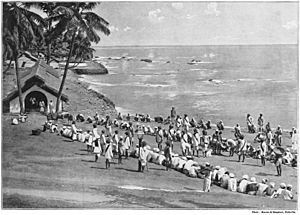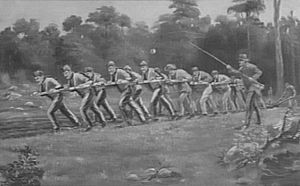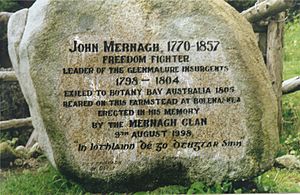Penal colony facts for kids
A penal colony is a settlement used to hold prisoners and use them for working in part of the state's (usually colonial) territories. This is much bigger than a prison farm. A famous penal colony was Devil's Island in French Guiana. The British Empire used its colonies in North America as penal colonies for more than 150 years. The first British settlements in Australia were started as penal colonies.
Common Features
Life in penal colony was often very hard, sometimes including severe physical punishment. Some prisoners were sentenced for the rest of their natural lives. Many died from hunger, disease, neglect, working too hard, or trying to escape.
In the penal colony system, prisoners were sent far away to stop escapes and to make it hard to get home after their prison term finished. Penal colonies were often in unsettled lands, especially places where no else wanted to work or live. The prisoners' unpaid work would help the government develop new areas without spending a lot of money.
British Empire
The British used parts of North America as a penal colony. Convicts would be transported by private companies and sold by auction to plantation owners. About 50,000 British convicts were sent to colonial America. This was about one quarter of British settlers during the 1700s.
After the American Revolution, Britain had to find somewhere else to send its prisoners. They established Sydney, Norfolk Island, Van Diemen's Land and Western Australia as big penal colonies.
In colonial India, the British had made various penal colonies. Two of the most infamous ones are on the Andaman islands and Hijli Detention Camp. In the early days of settlement, Singapore was sent Indian convicts. Their job was to clear the jungles for settlement and early public works.
France
France sent criminals to tropical penal colonies including Louisiana in the early 18th century. Devil's Island in French Guiana, 1852–1939, received forgers and other criminals. New Caledonia and its Isle of Pines in Melanesia (in the South Sea) received transported dissidents like the Communards, Kabyles rebels as well as convicted criminals between the 1860s and 1897.
Americas
- Brazil had a prison on the island of Fernando de Noronha from 1938 to 1945.
- Gorgona Island in Colombia housed a state high-security prison from the 1950s. Convicts were dissuaded from escaping by the venomous snakes in the interior of the island and by the sharks patrolling the 30 km to the mainland. The penal colony closed in 1984 and the last prisoners were transferred to the mainland. As of 2015[update] most of the former jail buildings are covered by dense vegetation, but some remain visible.
- Guantanamo Bay detention camp in Cuba is used by the United States as a penal colony.
- Mexico uses the island of Isla María Madre (in the Marías Islands) as a penal colony. With a small population (fewer than 1,200), the colony is governed by a state official who is both the governor of the islands and chief judge. The military command is independent of the government and is exercised by an officer of the Mexican Navy. The other islands are uninhabited. Mexico announced on 18 February 2019 that it will close the Islas Marías Federal Prison, replacing it with a new cultural center.
- During the 19th century Chile used Fuerte Bulnes and Punta Arenas on the Strait of Magellan as a penal colony (1844–1852).
- Ecuador has used two islands in the Galápagos archipelago as penal colonies: the Island of San Cristóbal (1869–1904) and Isabela Island (1945–1959).
- Paraguay's first ruler and supreme dictator José Gaspar Rodríguez de Francia opened the penal colony of Tevego in 1813, where mostly petty criminals were sent. It was abandoned in 1823, but re-established in 1843 as San Salvador. It was evacuated towards the end of the Paraguayan War of 1864–1870; soon afterwards Brazilian troops destroyed it.
- Argentina had a penal colony in Ushuaia, Tierra del Fuego, in the Patagonia region. It was active between 1902 and 1947.
- Once Spanish presence in Valdivia was reestablished in 1645 authorities had convicts from all-over the Viceroyalty of Peru construct the Valdivian Fort System. The convicts, many of whom were Afro-Peruvians, became later soldier-settlers. Close contacts with indigenous Mapuche meant many soldiers spoke Spanish and had some command of Mapudungun.
Elsewhere
- Following Alexander the Great's conquest of modern day Afghanistan and Pakistan, the Greco-Bactrian Kingdom was used as a penal colony. Today, 18% of the population of Peshawar has Greek genetic markers.
- The Meiji Government of Japan used Abashiri Prison in Abashiri, Hokkaido as a penal colony in 1890. The prison later turned into ordinary jail in 1894.
- The Qing Empire of 1636–1912 used general-ruled provinces Jilin (Ningguta) in north-east China and Xinjiang in north-west China as penal colonies.
- Imperial Russia used Siberia and Russian Far East for penal colonies (katorga) for criminals and dissidents. Though geographically contiguous with heartland Russia, Siberia provided both remoteness and a harsh climate. In 1857 a penal colony was established on the island of Sakhalin. The Soviet Gulag system and its tsarist predecessor, the katorga system, provided penal labor to develop forestry, logging, and mining industries, construction enterprises, as well as highways and railroads across Siberia and in other areas. In modern Russian Federation, corrective labor colonies are a common type of prison.
- The Kingdom of Hawaii under the rule of King Kamehameha III (reigned 1825–1854) replaced the death penalty with exile, and Kahoolawe became a men's penal colony sometime around 1830, while Kaena Point on Lanai served as the female penal colony. The law making the island a penal colony was repealed in 1853.
- Boven Digoel in Papua was once used by Dutch East Indies authorities as penal colony for revolutionaries.
- Buru Island in Indonesia was used as a penal colony during the New Order era to hold political prisoners.
- Apartheid South Africa used Robben Island as a penal colony for anti-apartheid activists.
- The Netherlands had a penal colony from the late 19th century. The Department of Justice took over the town of Veenhuizen (originally set up by a private company to "re-educate" vagrants from the large cities in the west like Amsterdam) to turn it into a collection of prison buildings. The town stands in the least populated province of Drenthe in the north of the country, isolated in the middle of a vast area of peat and marshland.
- Some sources refer to Nazi-era forced-labor camps (Arbeitslager) in German-occupied Europe as penal colonies.
- North Korea operates a penal system including prison labor camps and re-education camps.
- Tarrafal operated as a Portuguese penal colony in the Cape Verde Islands, set up in 1936 by the head of the Portuguese government, Salazar, where opponents of this right-wing regime were sent. At least 32 anarchists, communists and other opponents of Salazar's regime died in this camp. The camp closed in 1954 but re-opened in the 1970s to jail African leaders fighting Portuguese colonialism.
- Spain maintained a penal colony on Fernando Po in present-day Equatorial Guinea. The tiny island of Cabrera was also a short-lived penal colony in which approximately 7,000 French prisoners of war from the Battle of Bailén (1808) were left on their own for years; less than half of them survived.
- Taiwan had a penal colony at Green Island during Chiang Kai Shek's White Terror of 1949–1987. As of 2015[update] the island is a tourist destination.
- Côn Đảo Island in Vietnam was used as a penal colony both by the French colonists (from 1861 onwards) and by the Republic of Vietnam (from 1954 and during the Vietnam War of 1955–1975).
- The Ottoman Empire used Fezzan as a penal colony, because it was the most remote province from then the capital city, Istanbul.
- There are penal colonies in the Philippines, namely Iwahig Prison and Penal Farm in Palawan, and Davao Prison and Penal Farm in Davao.
Related pages
See also
 In Spanish: Colonia penal para niños
In Spanish: Colonia penal para niños




